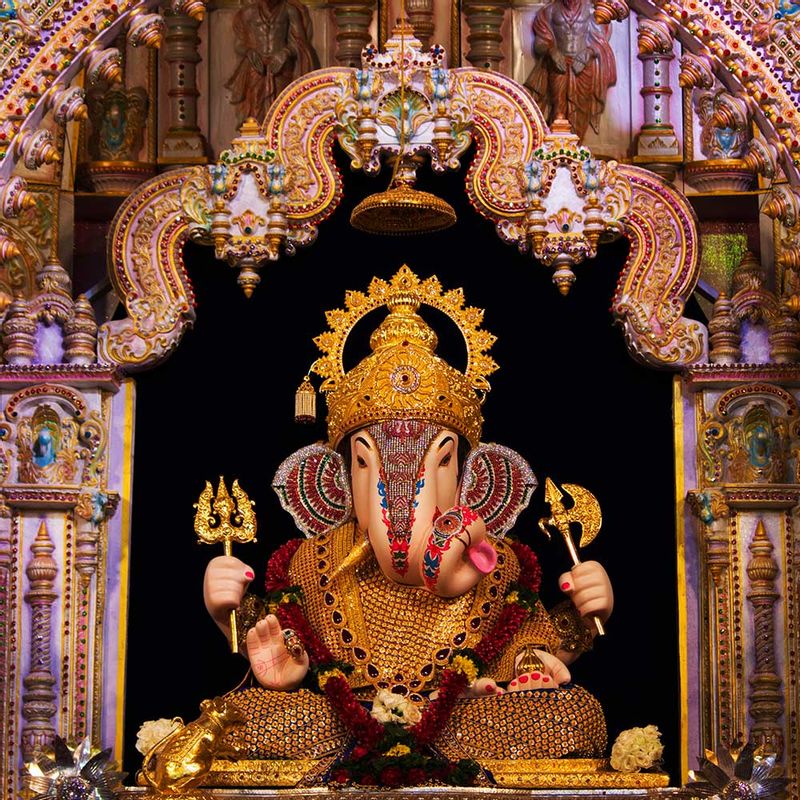Devotees of the Vighnaharta need no introduction to Pune's legendary Dagdusheth Halwai Ganpati Mandir. For over 127 years and counting, it has played a significant role in maintaining the tradition of Sarvajanik Ganpati or large-scale public celebrations of the ten-day festival.
Unlike any other Ganpati idol, Dagdusheth Ganpati casts a spell with its distinctive features, intricate ornaments and all its divine glory.
1. Named after a famous trader

The Shreemanth Dagdusheth Halwai Ganpati temple is named after a famous trader and sweet maker, Dagdusheth Halwai, who had moved to Pune from Karnataka and built the temple in Pune after losing his son to the plague.
The temple idol is currently insured for $1,60,000 (approximately Rs 1 crore). The Shrimant Dagdusheth Halwai Temple Trust, which is a part of the Mandal carries out various activities of social welfare.
2. From personal to public expense
The Sarvajanik Ganpati was freedom fighter Bal Gangadhar Tilak’s idea to unite and mobilise Indians against British rule. A meeting of several respected citizens of Pune, including Tilak’s good friend Dagdusheth Halwai, pondered over celebrating the festival amidst the conservative Puneri society.
To prepare the ground for a bigger celebration, Lokmanya Tilak first installed Ganpati idols at five neighbourhoods in Pune at his own expense. He also appealed to Pune’s citizenry to support the Sarvajanik Ganeshotsav through his newspaper Kesari. The celebrations gained currency and began to attract monetary contributions from 1896 onwards.
3. Richness to goodness

One of the most celebrated and star-studded Ganapati idols, the Dagdusheth Ganpati is bedecked with gold ornaments studded with precious stones. According to the trust’s 2017-18 audit report, the total property is valued at Rs. 66.91 crore. As part of its 125th-year celebrations in 2017, Pune jewellers, PN Gadgil and Sons, designed a 40-kg jewellery collection for the lord valued at INR 15 crores.
Over 40 craftsmen slogged around the clock for around five months, spending over 60,000 hours to prepare the gold jewellery studded with more than 60,000 precious stones such as rubies and emeralds.
From a 9.5 kg crown, seven changeable crowns for every day of the week to ornament for the trunk (Shunda Bhushan), Angarkha and much more, the ornaments feature traditional motifs like the lotus, kalash, elephant, kirtimukh, peacock and trident.
The Shreemanth Dagdusheth Halwai Sarvajanik Ganpati Trust is one of the richest trusts in Maharashtra and uses its donations for charitable and social welfare work.
4. There are not one but three idols
The first idol was built in 1893 by Baburao Naik with paper and sticky jaggery glue (randha) at an expense of Rs 22 and was formally installed by Lokmanya Tilak. This historic idol is now in the Akara Maruti Mandir of Shukrawar Peth.
The second idol was built by noted sweet merchant Dagdusheth Halwai in 1896, the year Pune was struck by the plague that claimed his son. The grieving parents, Dagdusheth and his wife Lakshmi, were advised by their guru to build idols of Datta and Ganesha.
The third idol was commissioned on Dagdusheth’s 75th anniversary in 1967 and is built of Plaster of Paris by an acclaimed sculptor from Karnataka, Nagesh Shilpi at a cost of Rs 1,125. In 2006, the trust commissioned the beautiful silver idol that is permanently on display at the temple throughout the year.
5. Decorations with a difference

The decorations during the Ganesha festival vary every year. Different aspects of India’s rich and diverse cultural heritage are brought to life—especially the replicas of ancient temples and palaces such as the legendary Madhura-Meenakshi temple, Surya Temple of Orissa, Shree Mahalaxmi temple of Kolhapur, the Mysore Palace, the Angola Palace of Rajasthan. So fabulous are the decorations that people throng to Pune from all over the country for a dekko.
6. Ganesha celebrations
There are five maha artis organised on a daily basis at set timings. The idol of Ganesha, heavily bedecked with jewellery, is an awe-inspiring sight. The manner in which the temple is built makes it possible for everyone to see the proceedings from outside.
A prominent feature during Ganesh Chaturthi celebrations is the participation of students from different schools in the recitation of the Ganpati Atharvashirsha at dawn.
Disclaimer: The views expressed in the article reflects the author(s) opinions and do not necessarily represent the views of the publisher and editor.


